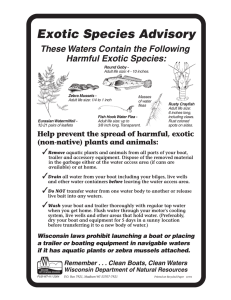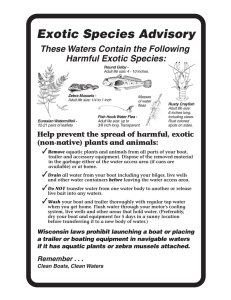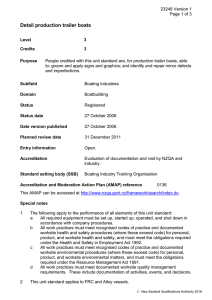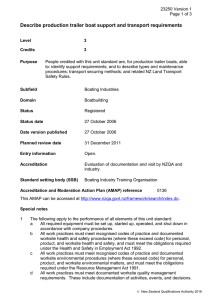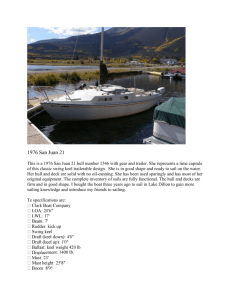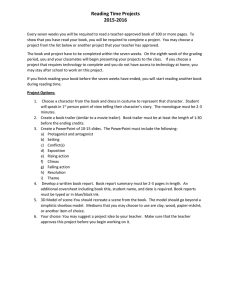Demonstrate knowledge of production trailer boat design
advertisement
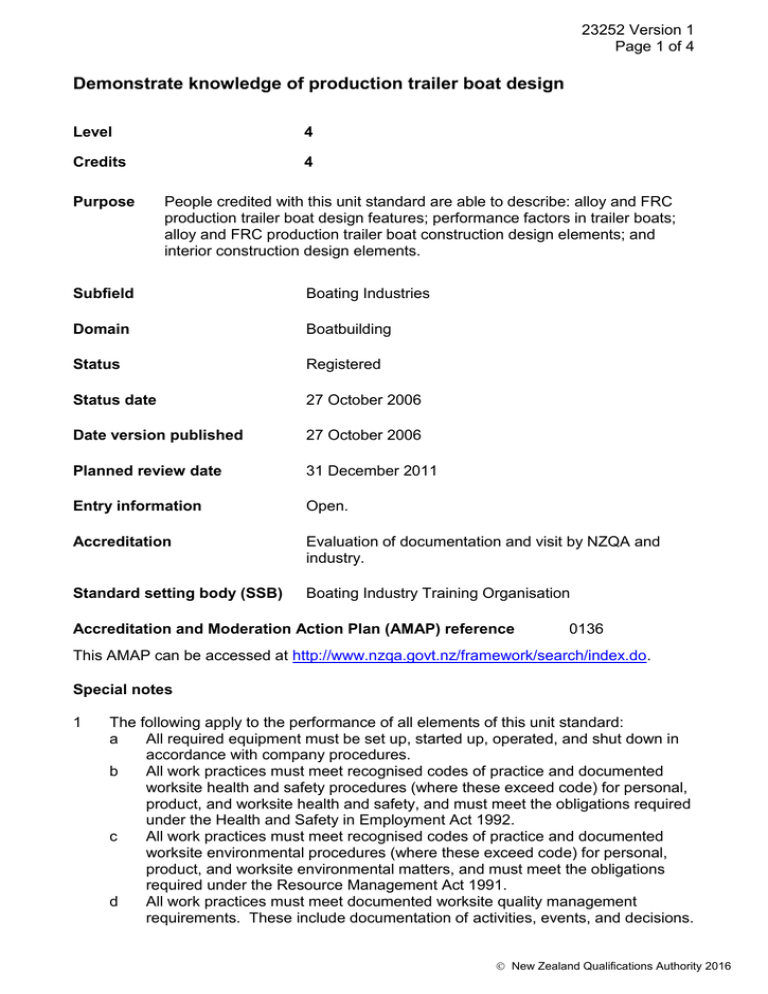
23252 Version 1 Page 1 of 4 Demonstrate knowledge of production trailer boat design Level 4 Credits 4 Purpose People credited with this unit standard are able to describe: alloy and FRC production trailer boat design features; performance factors in trailer boats; alloy and FRC production trailer boat construction design elements; and interior construction design elements. Subfield Boating Industries Domain Boatbuilding Status Registered Status date 27 October 2006 Date version published 27 October 2006 Planned review date 31 December 2011 Entry information Open. Accreditation Evaluation of documentation and visit by NZQA and industry. Standard setting body (SSB) Boating Industry Training Organisation Accreditation and Moderation Action Plan (AMAP) reference 0136 This AMAP can be accessed at http://www.nzqa.govt.nz/framework/search/index.do. Special notes 1 The following apply to the performance of all elements of this unit standard: a All required equipment must be set up, started up, operated, and shut down in accordance with company procedures. b All work practices must meet recognised codes of practice and documented worksite health and safety procedures (where these exceed code) for personal, product, and worksite health and safety, and must meet the obligations required under the Health and Safety in Employment Act 1992. c All work practices must meet recognised codes of practice and documented worksite environmental procedures (where these exceed code) for personal, product, and worksite environmental matters, and must meet the obligations required under the Resource Management Act 1991. d All work practices must meet documented worksite quality management requirements. These include documentation of activities, events, and decisions. New Zealand Qualifications Authority 2016 23252 Version 1 Page 2 of 4 2 Definition FRC – fibre reinforced composite, as used in this unit standard is a generic term that encompasses GRP (glass reinforced plastic). FRC may be laminated from any combination of fibres, cores and resins including polyester, vinylester and epoxy resins. Elements and performance criteria Element 1 Describe alloy production trailer boat design features. Performance criteria 1.1 Design shapes are described in terms of the limitations of flat plate construction. Range conic and cylindrical development, corner radius, details. 1.2 Maintenance and finish design considerations are described according to finish type. 1.3 Weight and cost of alloy designed production trailer boats are described in comparison with FRP. 1.4 Alloy manufacturing processes are described in terms of the effect the design features have on the manufacture. Range 1.5 speed of construction, kitsetting of components. Typical hull design forms are described in relation to V bottom configuration. Element 2 Describe FRC production trailer boat design features. Performance criteria 2.1 Design shape options for moulded FRC products are described in relation to the material fabrication process. Range ability to form compound curves. 2.2 Maintenance and finish design considerations are identified according to finish type. 2.3 Weight and cost aspects of production FRC designs are described in comparison with alloy trailer boats. New Zealand Qualifications Authority 2016 23252 Version 1 Page 3 of 4 2.4 Manufacturing process is described in terms of the effect the design features have on the manufacture. Range 2.5 from mouldings, assembly line. Typical hull design forms are described in relation to V bottom configuration. Element 3 Describe performance factors in trailer boats. Performance criteria 3.1 Effect of V in hull form is described in terms of boat performance. Range speed, ride, stability. 3.2 Effect of weight is described in terms of boat performance. 3.3 Power requirement variations are described in terms of boat performance. Range 3.4 speed differences with same power for different hull shapes. The effect of loading is described in terms of boat performance. Range distribution of weight, centre of gravity, handling. Element 4 Describe alloy production trailer boat construction design elements. Performance criteria 4.1 The use of alloy boat components are described in terms of trailer boat construction design. Range 4.2 includes but is not limited to – plating, bulkheads, girders, stringers, tanks. Alloy boat joining methods are described in terms of trailer boat construction design. Range typical welding details, riveting details, advantages and disadvantages. New Zealand Qualifications Authority 2016 23252 Version 1 Page 4 of 4 Element 5 Describe FRC production trailer boat construction design elements. Performance criteria 5.1 FRC boat components are described in terms of trailer boat design. Range 5.2 includes but is not limited to – typical mouldings, tank types, internal liners, stringers, girders. FRC boat joining methods are described in terms of trailer boat design. Range taping, bonding, flanges, fastenings. Element 6 Describe structural interior construction design elements. Performance criteria 6.1 Elements are identified in terms of trailer boat construction design. Range bunk fronts, bunk tops, bunk boards, material choices. Please note Providers must be accredited by the Qualifications Authority, or an inter-institutional body with delegated authority for quality assurance, before they can report credits from assessment against unit standards or deliver courses of study leading to that assessment. Industry Training Organisations must be accredited by the Qualifications Authority before they can register credits from assessment against unit standards. Accredited providers and Industry Training Organisations assessing against unit standards must engage with the moderation system that applies to those standards. Accreditation requirements and an outline of the moderation system that applies to this standard are outlined in the Accreditation and Moderation Action Plan (AMAP). The AMAP also includes useful information about special requirements for organisations wishing to develop education and training programmes, such as minimum qualifications for tutors and assessors, and special resource requirements. Comments on this unit standard Please contact the Boating Industry Training Organisation info@bia.org.nz if you wish to suggest changes to the content of this unit standard. New Zealand Qualifications Authority 2016

